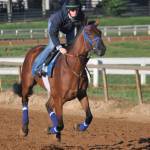Feeding Young Racehorses in Training

Young Thoroughbred horses often begin race training early in their two-year-old year before their physical growth is complete. Therefore, any feeding program must meet the requirements of continued maturation as well as the increased exercise level of workouts.
Two-year-olds will grow both taller and broader as they mature. To do so, they need calcium, phosphorus, and other minerals to build skeletal tissue, and protein for muscle development. The skeleton responds to loading by adding bone, and to idleness by losing some of this tissue. The change from pre-training days of free exercise in a pasture to long periods of stall confinement often leads to some demineralization in the skeleton, and weight-bearing work at the track should begin slowly to avoid injuring these weakened bones with too much strenuous exercise.
As training progresses, the bones will become stronger and thicker as they adapt to the increased demands of work, but this change takes some time. Fortified grain products formulated for young horses in race training will have the correct inclusion and ratio of minerals to support healthy bone growth. These products should be fed at the levels suggested on the feed bag or tag so that the horses get the level of fortification they need. Too much of some minerals can be just as harmful as too little, and keeping the right ratio of one mineral to another will prevent interactions that inhibit availability of the nutrients. Trainers need to watch for soreness or lameness in these young racehorses and lower the level of exercise if these signs are seen.
Dietary protein is important when horses are increasing lean muscle tissue in response to exercise. Not all protein is the same, however, and a feed product with a high level of protein may or may not provide the specific amino acids needed for growth and muscle development in young horses. Lysine, the most important amino acid for these functions, is not supplied by many grains such as oats that are traditionally fed to horses. Soy products included in feeds formulated for young Thoroughbreds in training are one way to supply lysine at the optimum level.
Though all equine diets should be based on good-quality forage, hay alone does not supply enough energy to support the needs of racehorses in training. Feed products offer additional calories from grains (corn, oats) and fat sources (oil, rice bran). Large grain meals have some dangers such as overwhelming the digestive system with starch and upsetting the balance of microbes in the hindgut. Diets high in grain also increase the likelihood that a horse will develop gastric ulcers, especially if hay availability is limited. Breaking grain meals into three or four smaller meals fed throughout the day will lessen these risks.
Hay that is always available gives the young horse something to do during his hours in the stall; increases the flow of saliva that buffers stomach acid; and provides some vitamins, minerals, protein, and energy. One of the most important functions of hay is keeping the digestive tract functioning properly, as roughage is the horse’s natural food and the organs of digestion are designed to process a steady flow of fibrous material.
Fresh, clean water should always be available as should salt, either loose or as a block. Other electrolytes are usually provided by a properly formulated grain ration designed for young horses in training. For horses that are heavily exercised in hot climates, electrolytes lost in sweat may need to be replaced by a supplement.
Trainers should keep an eye on body condition and should not let young horses in training drop below a score of four on the common nine-point scale. If horses begin to lose any significant amount of body weight during training, management changes should be made because these equines should be growing and adding muscle as they train. An evaluation by an equine nutritionist can indicate changes that might allow two-year-olds in training to progress without losing weight.








